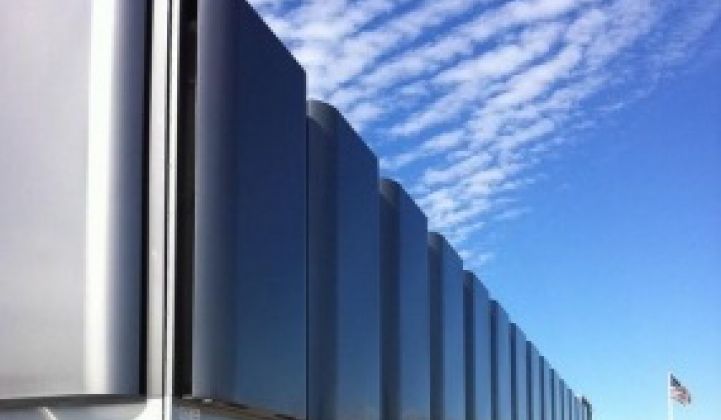Bloom Energy just announced a new source of capital and a new customer for its natural-gas-powered fuel cells. The ten-year-old, billion-dollar-funded startup claims to have installed more than 130 megawatts of its Bloom boxes in the U.S.
Solid-oxide fuel cell maker Bloom doesn't really provide information to the public or press about its corporate doings -- unless that member of the press is prepared to play the role of an unctuous sycophant.
We've reported on Bloom's spectacularly negotiated deal with Delaware utility Delmarva Power. We've covered the debatable "greenness" of the Bloom fuel cell. We've profiled the fuel cell industry as a whole.
Recently, we've heard less-than-positive things from a number of sources about the reliability of the Bloom fuel cell stack. In fact, we've heard that the fuel cell stack has a lifetime of six months to a year before it needs to be serviced. And we've read more of the repeated promises of profitability that Bloom never fails to include in its investor presentations.
Bloom has an electricity sales business, Bloom Electrons, which eliminates much of the risk for the customer as well as a leasing and ownership structure.
Bloom's most recent funding source is Exelon, the Chicago-based competitive energy provider, which will seek to finance 21 megawatts of Bloom's fuel cell deployments in any state with a favorable subsidy regime. According to a release, "Exelon’s partnership with Bloom Energy builds upon the distributed generation business of Exelon subsidiary Constellation." Exelon had 2013 revenues of approximately $24.9 billion from providing electricity and natural gas to more than 7.8 million customers in central Maryland (BGE), northern Illinois (ComEd) and southeastern Pennsylvania (PECO).
Exelon is the first energy firm to help finance Bloom's fuel cells.
Other recent fuel cell news:
- Last week, General Electric announced that it is initiating an entrepreneurial effort to commercialize its solid oxide fuel cell (SOFC) technology for megawatt-scale stationary power applications. Bloom Energy also works with SOFC technology at this scale. GE has claimed a recent fuel cell "breakthrough" with an efficiency of 65 percent (when used with a Jenbacher engine) and an overall efficiency of up to 95 percent when waste heat is captured. GE materials scientist Kristen Brosnan states that using an additive thermal spray technology "to deposit the anode and the electrolyte" makes it "easy to apply, [allowing it to] handle large temperature swings and...last a long time." That's the "game-changer" claimed by Wellington. GE plans to build a pilot plant and development facility near Saratoga Springs, New York.
- Doosan of South Korea, a conglomerate with $21 billion in 2013 revenue, just purchased the remains of bankrupt fuel-cell aspirant ClearEdge Power. The assets and debt sold for $32.4 million, according to the Yonhap News Agency, which reported that ClearEdge had 2013 revenue of $68 million. Dow Jones reports that the original bid was at a higher figure of $48 million. ClearEdge raised more than $136 million in VC funding since its founding in 2006 from Kohlberg Ventures, Applied Ventures (the investment arm of Applied Materials), Big Basin Partners, and Southern California Gas Company to develop and build a proton exchange membrane (PEM)-based fuel cell for residential and small commercial applications at hotels, multi-tenant buildings and schools. In December 2012, ClearEdge acquired the fuel cell business of technology conglomerate United Technology Corporation (UTC) and switched out its core PEM product to the UTC phosphoric acid technology for its 5-kilowatt and 400-kilowatt offerings. The natural-gas-powered UTC 400-kilowatt fuel cell unit had a reputation in the industry as one of the higher-performing products. UTC Power was spun out of Pratt & Whitney in 1958 and supplied fuel cells to NASA for space missions from 1966 through 2010. Around the same time as the April bankruptcy, Ballard Power acquired UTC's transportation- and stationary-related fuel cell IP assets for $22 million.
- Earlier this month, PEM fuel-cell maker Intelligent Energy went public and raised $94.1 million. The company was valued at $811 million, making it the most highly valued publicly held fuel cell company in the world. We look a bit deeper at the fuel cell market here.



